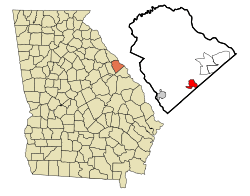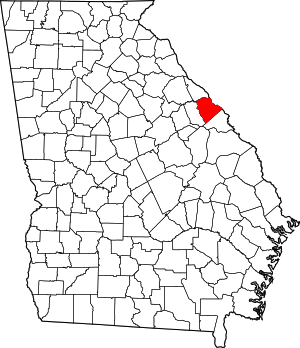Grovetown, Georgia
Grovetown is a city in Columbia County, Georgia, United States. It is part of the Augusta metropolitan area and the Central Savannah River Area. In the 2010 United States Census, it had a population of 11,216.[4] The mayor as of 2018 is Gary Jones.[1]
Grovetown, Georgia | |
|---|---|
| Motto(s): A community that cares | |
 Location in Columbia County and the state of Georgia | |
| Coordinates: 33°26′58″N 82°11′49″W | |
| Country | United States |
| State | Georgia |
| County | Columbia |
| Government | |
| • Mayor | Gary Jones[1] |
| Area | |
| • Total | 5.26 sq mi (13.63 km2) |
| • Land | 5.25 sq mi (13.60 km2) |
| • Water | 0.01 sq mi (0.03 km2) |
| Elevation | 482 ft (147 m) |
| Population (2010) | |
| • Total | 11,216 |
| • Estimate (2019)[3] | 15,152 |
| • Density | 2,885.00/sq mi (1,113.99/km2) |
| est. | |
| Time zone | UTC-5 (Eastern (EST)) |
| • Summer (DST) | UTC-4 (EDT) |
| ZIP Code | 30813 |
| Area code(s) | 706 |
| FIPS code | 1335716[4] |
| GNIS feature ID | 356123[5] |
| Website | Official website |
Geography
Grovetown is located in southern Columbia County at 33°26′58″N 82°11′49″W (33.449324, -82.196972).[5] Downtown Augusta is 15 miles (24 km) east. The northern boundary of Fort Gordon is 2 miles (3 km) south.
According to the United States Census Bureau, Grovetown has a total area of 4.8 square miles (12.5 km2), of which 0.01 square miles (0.03 km2), or 0.23%, is water.[6]
Transportation
Grovetown is mainly served by Georgia State Route 223 (SR 223), locally known as Robinson Avenue from just northwest of Fort Gordon's Gate 2 to the intersection with Harlem–Grovetown Road and as Wrightsboro Road past this point. It is also served by SR 388 east of this intersection. Here, SR 388 takes on the Wrightsboro Road name until an intersection with Katherine Street. At this intersection, the state highway turns left onto Horizon South Parkway, while Wrightsboro Road continues toward Augusta. Harlem–Grovetown Road connects the city with Harlem.
There are other important highways outside the city limits. Interstate 20 (I-20; Carl Sanders Highway), which heads west to Atlanta and east to Augusta and Columbia, South Carolina, is approximately 2 mi (3.2 km) to the north. US 78/US 278/SR 10, locally known as Gordon Highway, is located just south of the city limits north of Fort Gordon's Gate 2, and travels between Harlem and Augusta. SR 383 (Jimmie Dyess Parkway), is approximately 5 mi (8.0 km) to the east and connects Fort Gordon's Gate 1 to Evans. SR 232 (Columbia Road) is north of I-20 and connects the Appling area with Martinez and Augusta. US 221/SR 47 travels through Harlem. They connect Wrens and Harlem with Appling and northern Columbia County.
While there is no airport or other facility in Grovetown itself, the Augusta Regional Airport (also known as Bush Field) is approximately 17 miles (27 km) southeast of Grovetown. Also, Daniel Field, a public use airport is approximately 11 miles (18 km) to the east.
There are railroad tracks of CSX that extend through Grovetown. Freight trains mostly use these tracks.
Although there is no bus station in Grovetown, an intercity bus station is on Fort Gordon. The public may access the base for certain services and events.
History
From the building of the Georgia Railroad, which travels through the city until at least the 1860s, the community was known as "Belair".[7] The city was chartered by the Georgia Legislature and officially incorporated on January 1, 1881.[7] The name of the small village purportedly came from the old Grove Baptist Church that was founded in 1808. A poet famous in the post-Civil War era, Paul Hamilton Hayne, moved to Copse Hill in the Parham Road area in the 1860s. He solicited the United States Postal Service to establish the Grovetown post office. The first U.S. mail service was inaugurated on September 28, 1877, with Charles Clifford as postmaster. Mr. Clifford was also the train depot agent and the owner of the corner store.[8]
The first railroad depot was a small structure built in 1878–79. The last depot was an ornate structure built in 1891 at a cost of $5,041.74. It served the citizens of Grovetown until 1970, when passenger trains no longer traveled on the Augusta–Atlanta line. It was demolished in 1973.[8]
Many wealthy and influential Augusta residents had summer homes in Grovetown, escaping the heat and disease of the city. They commuted on the old "Picayune" train, relying on its frequent service. The Rosland Hotel, later known as the "Eagle", was built in the 1880s. Its huge rotunda was frequently used for church gatherings, suppers, parties, and dances. It later became a boarding house and burned in the 1970s. The Church of Christ is now located on the site.[8]
Several country stores were established on Old Wrightsboro Road near the railroad crossing. One was S. F. Poole's store, where the gazebo now stands at the corner with Robinson Avenue, with a "philosophers' bench" by the door. During the early days, many famous residents lived in the Grovetown area: Hayne, the literary figure; Stewart Phinizy and James Tobin, cotton brokers; Charles Phinizy, banker and railroad president; Dr. H. H. Steiner, physician; and John Dodge, pharmacist and harness racing enthusiast. Dodge brought his stable from Ohio and built a large home and racetrack.[8]
In the early 20th century Grovetown like many other Southern towns was not exempt from expressions of racism towards African Americans. A history long forgotten. On May 8, 1914, Montgomery Advertiser reported the following under the headline SHOE THIEF SUSPECT LYNCHED. Groveton, Ga, May 7-Charley Jones, a negro, was taken from two officers near here late last night by a number of white men and lynched. It is said that Jones was suspected of having shop lifted a pair of shoes.[9]
With the construction of Camp Gordon in 1942, Grovetown experienced rapid growth; it was no longer a small agricultural town. Many military families looked to Grovetown for housing. Gradually, more and more retired military saw the benefits of living in the small town and population began to grow and stabilize.[8]
Annexation and multi-housing construction has increased the population of the formerly quiet town. Currently, Grovetown has a population of approximately 15,000,[4] up from the 1990 census figure of 3,596. A variety of stores, dining establishments, schools, and churches add to the town's culture. Services include recreational facilities, a public safety department, two fire stations, water and sewer services, a senior center, and museum.[8]
Demographics
| Historical population | |||
|---|---|---|---|
| Census | Pop. | %± | |
| 1900 | 527 | — | |
| 1910 | 558 | 5.9% | |
| 1920 | 425 | −23.8% | |
| 1930 | 267 | −37.2% | |
| 1960 | 1,396 | — | |
| 1970 | 3,169 | 127.0% | |
| 1980 | 3,384 | 6.8% | |
| 1990 | 3,596 | 6.3% | |
| 2000 | 6,089 | 69.3% | |
| 2010 | 11,216 | 84.2% | |
| Est. 2019 | 15,152 | [3] | 35.1% |
| U.S. Decennial Census[10] | |||
As of 2018,[4] there were 14,473 people and 4,370 households residing in the city. As of the 2010 United States Census, the population density was 2,326.0 people per square mile (3,721.6/km2). There were 2,473 housing units at an average density of 857.7 per square mile (331.5/km2). The racial makeup of the city was 56.0% White, 31.3% African American, 1.4% Native American, 1.3% Asian, 0.0% Pacific Islander, and 8.1% from two or more races. Hispanic or Latino of any race were 13.3% of the population.
In the city, the population was spread out, with 29.7% under the age of 18 and 6.1% who were 65 years of age or older.
The median income for a household in the city was $61,152, and the median income for a family was $32,546. The per capita income for the city was $21,256.
Schools
Grovetown Middle School, Grovetown Elementary School and Cedar Ridge Elementary School serve the city.[11]
Parks
Grovetown has some city parks. They include the Liberty Park Community Center on Newmantown Road[12] and Goodale Park on Wrightsboro Road,[12] which is named after Joseph Daniel "Danny" Goodale Jr., a Vietnam veteran who died in 1969.[13][14]
References
- "Gary Jones". Cityofgrovetown.com. Retrieved February 11, 2018.
- "2019 U.S. Gazetteer Files". United States Census Bureau. Retrieved July 9, 2020.
- "Population and Housing Unit Estimates". United States Census Bureau. May 24, 2020. Retrieved May 27, 2020.
- "QuickFacts: Grovetown city, Georgia". United States Census Bureau. Retrieved April 1, 2020.
- "GNIS Detail – Grovetown". United States Geological Survey. Retrieved February 11, 2018.
- "Geographic Identifiers: 2010 Demographic Profile Data (G001): Grovetown city, Georgia". U.S. Census Bureau, American Factfinder. Archived from the original on February 12, 2020. Retrieved July 29, 2014.
- "Grovetown". Georgia.gov. Archived from the original on January 10, 2019. Retrieved February 11, 2018.
- "City History". Cityofgrovetown.com. Retrieved February 11, 2018.
- Ginzburg, Ralph (1962). 100 Years of Lynchings. Black Classic Press. p. 91. ISBN 978-0-933121-18-8.
- "Census of Population and Housing". Census.gov. Retrieved June 4, 2015.
- "Education". Cityofgrovetown.com. Retrieved February 11, 2018.
- "Parks and City Facilities". Cityofgrovetown.com. Retrieved April 1, 2020.
- "Grovetown remembers fallen soldier". The Augusta Chronicle. May 26, 1997. Retrieved April 1, 2020 – via NewsBank.
- "Joseph D Goodale Jr –Army". Virtual Vietnam Veterans Memorial Fund. Retrieved February 11, 2018.
